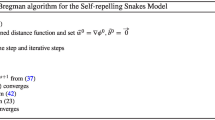Abstract
We propose a snake-based approach that allows a user to specify only the distant end points of the curve he wishes to delineate without having to supply an almost complete polygonal approximation. This greatly simplifies the initialization process and yields excellent convergence properties. This is achieved by using the image information around the end points to provide boundary conditions and by introducing an optimization schedule that allows a snake to take image information into account first only near its extremities and then, progressively, toward its center. In effect, the snakes are clamped onto the image contour in a manner reminiscent of a ziplock being closed.
These snakes can be used to alleviate the often repetitive task practitioners face when segmenting images by eliminating the need to sketch a feature of interest in its entirety, that is, to perform a painstaking, almost complete, manual segmentation.
Similar content being viewed by others
References
Arnold, V. I. 1973. Ordinary Differential Equations. MIT Press.
Bascle, B. and Deriche, R. 1993. Stereo matching, reconstruction and refinement of 3D curves using deformable contours. In International Conference on Computer Vision, Berlin, Germany, pp. 421-430.
Berger, M. O. and Mohr, R. 1990. Towards autonomy in active contour models. In Tenth International Conference on Pattern Recognition, Atlantic City, NJ, 847-851.
Berger, M.-O. 1991. Les contours actifs: modélisation, comportement et convergence. Ph. D. thesis, Instiut National Polytechnique de Lorraine, Inria Lorraine, Centre de Recherche en Informatique de Nancy, France.
Bush, A. W. 1992. Perturbation Methods for Engineers and Scientists. CRC Press.
Cohen, L. D. 1991. On active contour models and balloons. Computer Vision, Graphics, and Image Processing: Image Understanding, 53(2):211-218.
Courant, R. and Hilbert, D. 1989. Methods of Mathematical Physics, Vol. 1, Wiley: New York, 1989.
Davatzikos, C. A. and Prince, J. L. 1993. Adaptive active contour algorithms for extracting and mapping thick curves. In Proceedings of 1993 IEEE Computer Society Conference on Computer Vision and Pattern Recognition, pp. 524-529.
Fua, P. and Leclerc, Y. G. 1990. Model driven edge detection. Machine Vision and Applications, 3:45-56.
Henricsson, O. and Neuenschwander, W. 1994. Controlling growing snakes by using key-points. In International Conference on Pattern Recognition, Jerusalem, Israel, pp. 68-73.
Kass, M., Witkin, A., and Terzopoulos, D. 1988. Snakes: Active contour models. International Journal of Computer Vision, 1(4):321- 331.
Leymarie, F. and Levine, M. D. 1993. Tracking deformable objects in the plane using an active contour model. IEEE Transactions on Pattern Analysis and Machine Intelligence, 15(6):617- 634.
Neuenschwander, W. 1995. Elastic deformable contour and surface models for 2-D and 3-D image segmentation. Ph. D. thesis, Swiss Federal Institute of Technology, Zurich, Switzerland.
Staib, L. H. and Duncan, J. S. 1992. Boundary finding with parametrically deformable models. IEEE Transactions on Pattern Analysis and Machine Intelligence, 14(11):1061-1075.
Terzopoulos, D. 1987. On matching deformable models to images. Topical Meeting on Machine Vision Tech. Digest Series, 12:160- 167.
Terzopoulos, D., Witkin, A., and Kass, M. 1987. Symmetry-seeking models for 3D object reconstruction. International Journal of Computer Vision, 1(3):211-221.
Terzopoulos, D. and Szeliski, R. 1992. Tracking with Kalman snakes. In Active Vision, A. Blake and A. Yuille (Eds.), The MIT Press.
Author information
Authors and Affiliations
Rights and permissions
About this article
Cite this article
Neuenschwander, W.M., Fua, P., Iverson, L. et al. Ziplock Snakes. International Journal of Computer Vision 25, 191–201 (1997). https://doi.org/10.1023/A:1007924018415
Issue Date:
DOI: https://doi.org/10.1023/A:1007924018415




